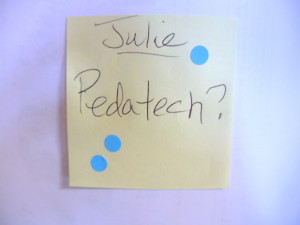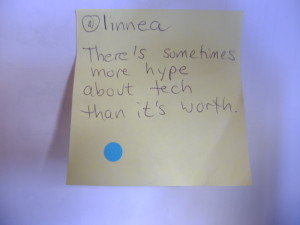Like the healing water of her world-renowned baths, something else was bubbling up in Budapest: the issue of NNESTs.
Jeremy Day’s entertaining and informative plenary opened the IATEFL BESIG Summer Symposium 2015. He gave us an account of his journey through the world of ELT and offered some critical insights on the subject of NNESTs, ending with a recommendation of Tefl Equity Advocates. One central point of his talk was that we need to supercede the ‘NESTs or NNESTS‘ slanging match.
As I’ve said before, surely we are one teaching community…
One story Jeremy related illustrates the dichotomy between industry and profession I noted in a previous blog post. Jeremy was interviewing for a teacher position at a well-known language school in Warsaw, Poland, and one of the candidates was a local Polish teacher.
In terms of pedagogical knowledge and skills, she was clearly the best teacher for the job. But when he told his superior that she was the best candidate, the response was: “That was a mistake, you shouldn’t even have interviewed her”. The school operated a native-speaker only policy at the time, putting profit before pedagogy.
Needless to say, this same Polish teacher has gone on to write best-selling ELT books for the Polish market.
And the language school? It closed.
Building Bridges in Budapest
Rachel Appleby’s excellent talk started off with the wonderful idea of Building Bridges–which seemed like an good metaphor both in terms of the nine bridges of Budapest and in terms of what a conference should be: building connections between people and building skills.
Rachel took us through three case studies of real learners and illustrated how we might approach different ESP learners and ‘find a way in’.
Jasmina Latinovis and Tatjana Stanimirovic, both local teachers, gave us some practical activities to ‘wake our business students up’ – sharing online activities and games. I particularly enjoyed the hands-on part of this session, where we got to try out some activities.
what a conference should be: building connections between people and building skills.
Roy Bicknell’s session in the afternoon was another hands-on session: ‘Doing the Hub–Working towards an improvisational classroom’. He started with the John Cage axiom ‘Begin Anywhere’ and used this as a prompt for open-ended activities which, while deceptively simple, produced a lot of language. One activity I’ll definitely try out is ‘Concentric Circles’. Here learners draw a series of concentric circles on a large sheet of paper, putting important ideas or concepts in the middle, less important in the outer circles.
Dr. Jasmina Sazdovska rounded off the day by highlighting the difference between a Process and Product approach to teaching Presentation Skills, drawing attention to the fact that in the real world, presentations are usually part of a longer process. Therefore, we shouldn’t black-box the teaching of presentations but should move towards a more holistic, process-based approach.
I’d also like to give a special thanks to all the local organisers of the event, and particularly to Rachel Appleby, Mary Sousa and Nora Németh for showing us some of the delights of Budapest!
Last year when I presented in Graz I was incredibly nervous, this year I was just…nervous. But I would still encourage any teachers out there who are thinking of presenting at a conference to go for it–the distance the presenters and audience isn’t that big.
Also, the title of my presentation is a little misleading–it’s actually about bringing the ‘experience of tech’ back into the classroom.
I started my presentation with three projects:
Berlin Language Worker GAS – A grassroots organisation to improve working conditions for freelance teachers in Berlin
Teachers as Workers SIG – A grassroots organisation aiming to improve working conditions for ELT / ESL teachers globally
Teacher Stories – A place where ELT / ESL teachers tell their own stories
These projects are all animated by the same spirit: a spirit of critical thinking.
The paper that anchored my ideas, that explained what critical thinking was, and which resonated with me was On Teaching to Be Critical by John Passmore (1967).
This paper answers a question: what is critical thinking and how can we begin to teach it? Is creative thinking a habit, a character trait, a skill? Obviously, there are skills involved: constructing and deconstructing arguments, spotting fallacies, and so on. But this doesn’t not capture the essence of critical thinking. Passmore states that a vital component of critical thinking is imagination and creativity, what he calls “critico-creative thinking”.
Let me illustrate this by contrasting two critics: Bertholt Brecht and Julian Assange.

Both figures are ‘gadflies’, they annoy and criticise the regimes of their time; Assange even points out counter-arguments and presents new facts which highlight inconsistencies in what we, the public, are told. But it’s Brecht who provides a truly creative vision—his criticism has an imaginative blade, which gives it greater cutting power.
I spoke about Edtech and the fact that, as Neil Selwyn (2014: vii) writes, “Digital technologies have long promised much in the way of changing education along more democratic, more equitable and fairer lines, but have usually delivered far less.”
I also spoke about Social Media which, while connecting people in new ways, also has a downside. While being told that we “are the media”, and that we can “control our own content”, in effect we are “invisible labourers”. We provide the content for services such as Facebook and Twitter, content which is measured, bundled and sold to marketing companies. Moreover, as well as being able to connect with others–we can also surveil others.
Digital technologies have long promised much in the way of changing education….but have usually delivered far less.
This insight is grounded in the work of Robert W. Gehl and his book Reverse Engineering Social Media: Software, Culture, and Political Economy in New Media Capitalism (2014). This book is itself a creative act, as Gehl not only points out the downsides of Social Media, but also suggests ways to resist the commodification of social media such as using new social networks like Diaspora. He also charts the development of a more corporate Social Media by analysing the demise of Myspace which, until 2007 was the leading Social Media platform.
If we look at Myspace (above), we see an anarchic, decentralised space whereby each user could tweak or ‘pimp’ their profile. It was extremely user-centred. But this advantage was also its downfall. Myspace couldn’t provide a consistent space for advertisers–and with no consistent space, the process of advertising was complicated and advertisers couldn’t get reliable metrics on the effectiveness of their ads.
Facebook solved this problem by providing a consistent space, an interface that stayed the same across the user base. Here, advertisers could place their ads in one spot, and accurately measure their effectiveness: an advertisers dream. Compared to Myspace it’s predictable, consistent and corporate.
Question: why doesn’t Facebook have a ‘Dislike’ button?

This is because Social Media platforms built purely for profit are designed to make you do certain things and feel certain things. Introducing a ‘dislike’ button, although it make Facebook more democratic, would introduce an unwelcome critical tone.
But we can’t keep tech out of the classroom, because our learners love tech; that’s sometimes the problem. If there’s a spare second, then out comes the phone to check Facebook or WhatsApp feeds. Why is this so engaging? Because it’s personal, social, and there’s a constant flow of information. So if I want to design learning activities to engage learners, I should try and design in these qualities.
So, my research question was: Can I reverse engineer the experience of tech… and introduce this back into the classroom…without the tech?
My answer was YES – with learning activities like Paper Twitter. I’ve blogged about this activity before here, but in Budapest I piloted this activity for the third time. This is lesson design by iteration, where you build in gradual improvements based on feedback. One of the aims of this presentation was to show teachers that instead of throwing away activities (and photocopies, old lesson plans) we should pilot them again and again and make improvements.
Rather than a throwaway pedagogy, I want a sustainable pedagogy.
So here’s some instructions for Paper Twitter, and below are a few photos from the workshop. My favourite tweet – someone suggested the idea of combining pedagogy with tech: Pedatech!
Though what that says about the current connection between pedagogy and tech I’m not sure…
At the end of my presentation I encouraged my audience to be critical AND creative, to reverse engineer the experience of tech in their own contexts, and introduce this back into their classrooms.
Maybe you can do this too?
Conclusion
I really enjoyed the summer symposium, and may even have mended a few bridges myself. Comments and suggestions are, as always, welcome about any of the topics I’ve mentioned here.
Also, any teachers with writerly ambitions–NESTs or NNESTs–feel free to join our Teacher Stories Google+ group for support and encouragement in writing your Teacher Stories.
Bring on the pedagogical revolution! What next?
Paper powerpoints, paper websites?
Who knows?
References
Gehl, R. W. (2013). A history of like. The New Inquiry.
Selwyn, N. (2014), Distrusting Educational Technology: Critical Questions for Changing Times. Routledge.
Images
Budapest, by mi..chael on flickr. Attribution-NonCommercial 2.0 Generic (CC BY-NC 2.0)
Inside the Szechenyi baths, by Erwan Martin on flickr. Attribution 2.0 Generic (CC BY 2.0)















Thanks, Paul – great write-up and snapshot of an excellent event. (Feeling very privileged to have been included – thank you!)
Good, too, to have a summary of your presentation – looks like a lot of fun, & thought provoking too!
See you again soon … BESIG SItges Nov.?
Hi Rachel,
Thanks for your kind comments! Would love to go to Sitges, but have too much on. I prefer smaller events too.
But I’ll put my conference wings on again next year – the Berlin winter is a good motivator for writing conference proposals!